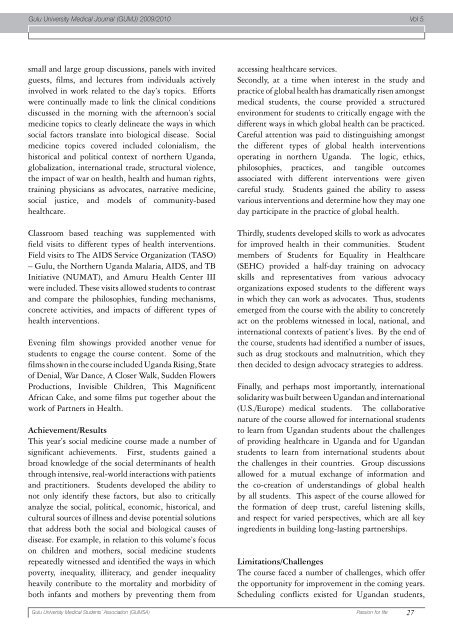GULU UNIVERSITY MEDICAL JOURNAL
GULU UNIVERSITY MEDICAL JOURNAL
GULU UNIVERSITY MEDICAL JOURNAL
Create successful ePaper yourself
Turn your PDF publications into a flip-book with our unique Google optimized e-Paper software.
Gulu University Medical Journal (GUMJ) 2009/2010 Vol 5.<br />
small and large group discussions, panels with invited<br />
guests, films, and lectures from individuals actively<br />
involved in work related to the day’s topics. Efforts<br />
were continually made to link the clinical conditions<br />
discussed in the morning with the afternoon’s social<br />
medicine topics to clearly delineate the ways in which<br />
social factors translate into biological disease. Social<br />
medicine topics covered included colonialism, the<br />
historical and political context of northern Uganda,<br />
globalization, international trade, structural violence,<br />
the impact of war on health, health and human rights,<br />
training physicians as advocates, narrative medicine,<br />
social justice, and models of community-based<br />
healthcare.<br />
Classroom based teaching was supplemented with<br />
field visits to different types of health interventions.<br />
Field visits to The AIDS Service Organization (TASO)<br />
– Gulu, the Northern Uganda Malaria, AIDS, and TB<br />
Initiative (NUMAT), and Amuru Health Center III<br />
were included. These visits allowed students to contrast<br />
and compare the philosophies, funding mechanisms,<br />
concrete activities, and impacts of different types of<br />
health interventions.<br />
Evening film showings provided another venue for<br />
students to engage the course content. Some of the<br />
films shown in the course included Uganda Rising, State<br />
of Denial, War Dance, A Closer Walk, Sudden Flowers<br />
Productions, Invisible Children, This Magnificent<br />
African Cake, and some films put together about the<br />
work of Partners in Health.<br />
Achievement/Results<br />
This year’s social medicine course made a number of<br />
significant achievements. First, students gained a<br />
broad knowledge of the social determinants of health<br />
through intensive, real-world interactions with patients<br />
and practitioners. Students developed the ability to<br />
not only identify these factors, but also to critically<br />
analyze the social, political, economic, historical, and<br />
cultural sources of illness and devise potential solutions<br />
that address both the social and biological causes of<br />
disease. For example, in relation to this volume’s focus<br />
on children and mothers, social medicine students<br />
repeatedly witnessed and identified the ways in which<br />
poverty, inequality, illiteracy, and gender inequality<br />
heavily contribute to the mortality and morbidity of<br />
both infants and mothers by preventing them from<br />
accessing healthcare services.<br />
Secondly, at a time when interest in the study and<br />
practice of global health has dramatically risen amongst<br />
medical students, the course provided a structured<br />
environment for students to critically engage with the<br />
different ways in which global health can be practiced.<br />
Careful attention was paid to distinguishing amongst<br />
the different types of global health interventions<br />
operating in northern Uganda. The logic, ethics,<br />
philosophies, practices, and tangible outcomes<br />
associated with different interventions were given<br />
careful study. Students gained the ability to assess<br />
various interventions and determine how they may one<br />
day participate in the practice of global health.<br />
Thirdly, students developed skills to work as advocates<br />
for improved health in their communities. Student<br />
members of Students for Equality in Healthcare<br />
(SEHC) provided a half-day training on advocacy<br />
skills and representatives from various advocacy<br />
organizations exposed students to the different ways<br />
in which they can work as advocates. Thus, students<br />
emerged from the course with the ability to concretely<br />
act on the problems witnessed in local, national, and<br />
international contexts of patient’s lives. By the end of<br />
the course, students had identified a number of issues,<br />
such as drug stockouts and malnutrition, which they<br />
then decided to design advocacy strategies to address.<br />
Finally, and perhaps most importantly, international<br />
solidarity was built between Ugandan and international<br />
(U.S./Europe) medical students. The collaborative<br />
nature of the course allowed for international students<br />
to learn from Ugandan students about the challenges<br />
of providing healthcare in Uganda and for Ugandan<br />
students to learn from international students about<br />
the challenges in their countries. Group discussions<br />
allowed for a mutual exchange of information and<br />
the co-creation of understandings of global health<br />
by all students. This aspect of the course allowed for<br />
the formation of deep trust, careful listening skills,<br />
and respect for varied perspectives, which are all key<br />
ingredients in building long-lasting partnerships.<br />
Limitations/Challenges<br />
The course faced a number of challenges, which offer<br />
the opportunity for improvement in the coming years.<br />
Scheduling conflicts existed for Ugandan students,<br />
Gulu University Medical Students’ Association (GUMSA) Passion for life 27


